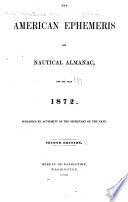 January 4th, 11 o'clock, AM, civil time. If the longitude from Greenwich be expressed in time, and, when west, added to the local time, or, when east, subtracted from the local time, the result is the corresponding Greenwich time. If the local mean time... January 4th, 11 o'clock, AM, civil time. If the longitude from Greenwich be expressed in time, and, when west, added to the local time, or, when east, subtracted from the local time, the result is the corresponding Greenwich time. If the local mean time...  The American Ephemeris and Nautical Almanac - Page 5081892Full view The American Ephemeris and Nautical Almanac - Page 5081892Full view - About this book
 | William Ralston Balch - 1895 - 836 pages
...hours. If greater than twelve hours, we subtract twelve hours from it, add oo* to the days, and write AM If the longitude from Greenwich be expressed in time,...time is used, the result is the Greenwich mean time. The rule is the same whether we use mean or sidereal time. For general convenience, the time changing... | |
 | William Ralston Balch - 1895 - 830 pages
...iwclvhours. If greater than twelve hours, we subtract twelve hours from it, add ooc to the days, and write AM If the longitude from Greenwich be expressed in time,...when east subtracted from the local time, the result it the cof«8pondinp Greenwich time. If the local mean time is used, the result is the Greenwich mean... | |
 | United States Naval Observatory. Nautical Almanac Office - 1891 - 574 pages
...or, woen east, sul'tracied from the local time, the result is the correspondimig Greenwich time. It¿ the local mean time is used, the result is the Greenwich...Ephemeris. The rule is the same, whether we use mean o sidereal time. THE CALENDAR. The Calendar is divided into twelve months, and to each month are assigned... | |
 | United States Naval Observatory. Nautical Almanac Office - 1872 - 554 pages
...the longitude l>e expressed in time, and, when it is west, added to the local time, or, when it is east, subtracted from the local time, the result is the corresponding Greenwich time. If the local astronomical time is used, the result is the Greenwich astronomical time, which ordinarily is required... | |
| |